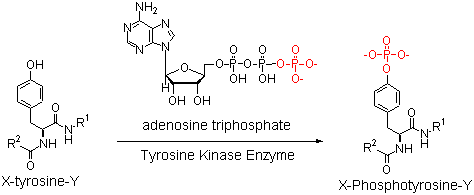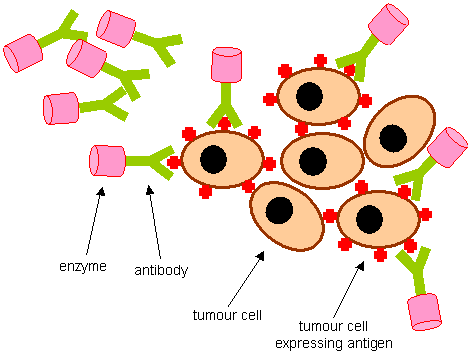
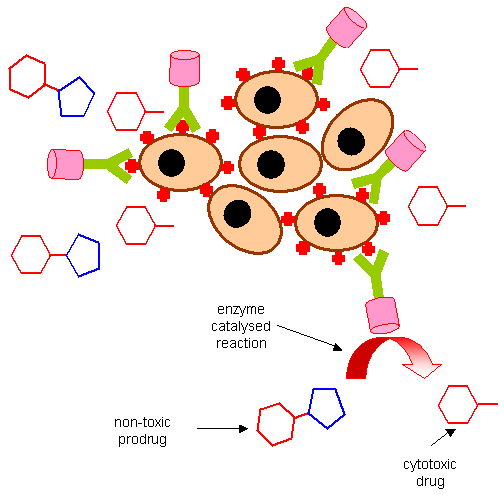
Cancer chemotherapy has had a huge impact both in curing and relieving the suffering of cancer patients. Currently one person in four with cancer is cured. In order to improve the cure rate, new approaches to chemotherapy are being developed. The main approaches are:
For many years scientists have tried to exploit the ability of antibodies to target cancer specific proteins (antigens) as a way of directing cytotoxic or radioactive therapies to tumours.
Unfortunately, the results have been disappointing and a number of difficulties have been identified.
One new strategy which avoids many of these problems is Antibody Directed Enzyme Prodrug Therapy.
ADEPT is made up of a minimum of two steps:
| (1) Targetting - an antibody attached to a chosen enzyme is given to the patient and allowed to localise at the site of the tumour |  |
| (2) Prodrug - a non-toxic prodrug is given to the patient |  |
Choice of enzyme
- the enzyme should ideally:Choice of Prodrug - the prodrug should ideally:
The components of an experimental ADEPT system which has entered clinical trials:
Enzyme |
Prodrug |
Active Drug |
| Bacterial Carboxypeptidase G2 (CPG2) |  |
 |
Greater understanding of the genetics and biology of cancer cells and tumours is allowing the identification of new rational targets for therapy. New drugs are being discovered by the use of innovative technology including high-throughput screening, combinatorial chemistry and structure-based drug design.
Cancer cells have a collection of mutated or missing genes. Oncogenes are mutated genes linked with cancer.
Tumour suppressor genes are often damaged or missing in cancer and so allow an accumulation of mutations.
Genetic abnormalities causing cancer can arise in a number of ways:
The accumulation of genetic damage to change a normal cell into a cancer cell is a multi-step process. A number of genetic changes are required to allow the tumour to grow, recruit blood vessels, invade surrounding tissues and spread to distant sites in the body.
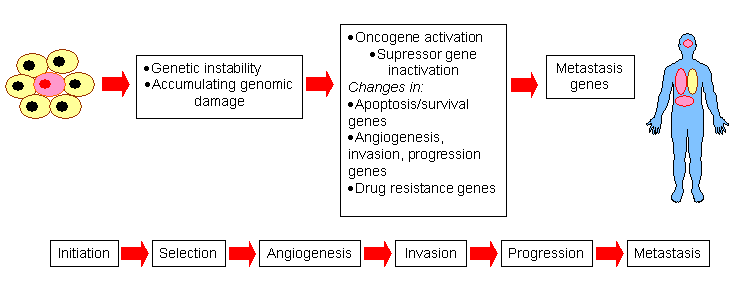
Despite the hype, not every mutant gene found in cancer cells will provide a target protein for cancer therapeutics.
A clear link between the presence of the gene and the cancerous state must be established. Evidence that removing the gene or functioning protein will restore cells to a normal state is also needed.
Prototype drugs ultimately will provide proof if the target will be of use for therapy.
Example 1: Inhibitors of Bcr-Abl Tyrosine kinase
The Philadelphia chromosone is found in 95% of cases of chronic myelogenous leukemia.
It is formed by the swapping of part of chromosones 9 and 22.
The mutation results in the formation of a new gene containing part of the Bcr gene from chromosone 22 and part of the Abl gene from chromosone 9.
The normal c-Abl gene produces a tyrosine kinase enzyme which is tightly controlled within the cell.
In contrast, the Bcr-Abl mutant protein is permanently switched on and causes the cells to become cancerous.
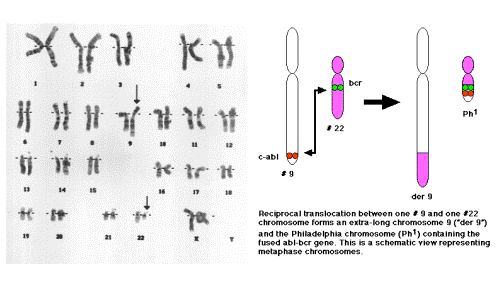
STI 571 has been discovered to be a potent and selective inhibitor of the Bcr-Abl kinase.
It binds to the enzyme at the adenosine triphosphate binding site and makes crucial hydrogen bond interactions with the enzyme, as seen in the Xray crystal structure.
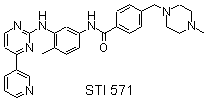
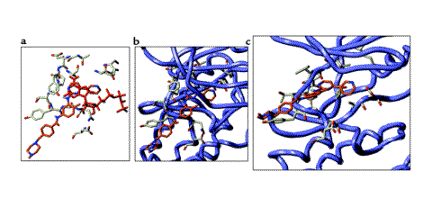
STI 571 is currently in clinical trials.
In phase I studies patients were treated with 25 to 600 mg/m2.
The side effects were anemia, nausea and indigestion, and cramps, athralgia and oedema.
A maximum tolerated dose was not reached.
Haematological responses were seen in 31 of 31 patients treated with >300 mg/m2.
Complete responses were seen in a number of patients.
Novel therapies targetted to cancer specific proteins promise to deliver non-toxic, selective and effective treatments.
Tyrosine Kinases
Kinase enzymes transfer the terminal phosphate of ATP onto an amino acid with a hydroxyl group i.e. tyrosine, serine or threonine.
